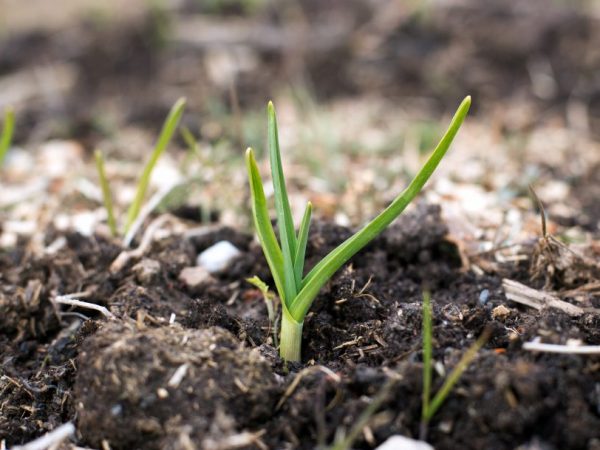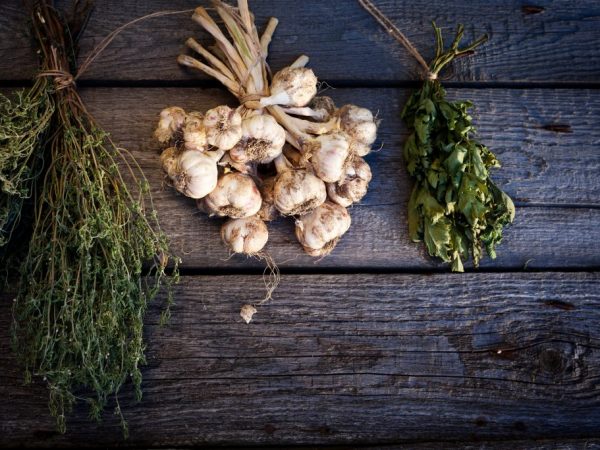Winter garlic care in spring
Winter garlic is a popular variety in the Slavic region, there are as many as 19 varieties against 7, its spring counterpart, Yarovoy. This preference in breeding can be explained by the fact that Winter is more spicy, its cloves are larger, this makes cleaning easier. Caring for garlic in the spring requires some preparation, which we will look at in this article.

Winter garlic care in spring
Features of winter garlic
Planting of garlic is done in the fall to leave it for the winter. Harvesting earlier than at Yarovoye is usually guided by the feast of Peter and Paul. But this is not entirely true: it would be much better to look at the state of the plant, because there are a lot of things that affect the rate of ripening.
Unlike Yarovoye, Winter garlic can be propagated with arrows. Its teeth grow around the stem, even and always in an even number. And their taste is much more expressive than that of spring.
Winter garlic is somewhat more comfortable to grow. It does not require an early trip to the dacha, like Yarovaya, which means that time can be spent on other work. Arrow propagation will save your crop and get rid of pests that settle on the cloves. Its increased spiciness is due to its high content of essential oils, so it is healthier.
Dignity
Positive sides:
- comfortable fit;
- rapid maturation;
- high productivity;
- reproduction by arrows;
- more spicy and more pronounced taste;
- easy peeling.
disadvantages
- shorter shelf life. It's good if it doesn't go bad before the beginning of January.
- May die during wintering if it is too harsh (below -25).
- Regional sensitivity. Imported from other regions can show itself badly.
So that the short shelf life does not become a nuisance, winter garlic is used to the maximum: in conservation, cooking, and bite with borscht. If the culture is threatened by a harsh winter, it is planted a little deeper to protect it from frost, and covered from above. Buying garlic on the market for planting can be a bad idea: varieties imported, for example, from the southern regions, can show a poor harvest, or even die altogether. Therefore, it would be right to take an interest in local varieties, select the largest ones, and only then start breeding them yourself.
Landing for the winter

Planting garlic in winter is not difficult
Timing
Planted in late September - mid-November, the exact time depends on the region, the colder, the earlier, this should be done 35-45 days before frost. Having planted it earlier, you will get a higher yield, but if it has time to germinate before frost, it will die, so you need to choose the optimal time. So that the cold does not overtake the plant by surprise, take note of what spring was like: if it is early, frosts will come earlier than usual. In this case, planting occurs in the first decade of September.
A place
When choosing a place for planting, you need to take care that garlic and onions did not grow here last year, the earth rests from them for 3-5 years.It would be a good idea to choose an area where melons grew: cabbage, squash, pumpkins, zucchini or legumes, but after nightshades it feels bad. By planting garlic next to strawberries and other berries, you can kill two birds with one stone: protect vulnerable crops, and provide the bulb with good conditions, such neighbors are to her liking.
Treatment
So that early spring does not suddenly happen to the garlic, I process it with potassium permanganate, soaking the previously dried cloves for 2-3 hours. The solution should be pink, this procedure will protect it from disease. To enhance the effect, you can soak in a strong salt solution, a tablespoon per liter of water for 2-3 minutes, copper sulfate is also suitable, half a teaspoon per 1 liter. water, stand in the same way as in salt.
Make sure the cloves are free from the bottom, otherwise it will interfere with the roots. When planting garlic, adhere to a distance of 10-15 cm, and between rows 20-25 cm. Place the cloves in the hole gently, efforts can damage it, and root growth will be disrupted.
If the frost is expected to be fatal, below -25, or the winter cover will be weak, you need to take care of the shelter especially well. For this, dry plants are used, covered with a film, agricultural cloth or other suitable material. With the onset of spring, they get rid of the shelter.
Garden bed care
Caring for the planting of winter garlic in the spring begins with top dressing: the seedlings are flavored with urea dissolved in water, in a ratio of 10-15 g per 1 sq. m. of land. When the arrows are extended to 15-20 cm, they are cut to 5 cm, this is done to increase yield, several arrows from the largest bulbs can be left for reproduction. To accelerate maturation, the soil covering the head is raked.
Productivity significantly (35-42%) depends on moisture.
Therefore, caring for winter garlic in the spring includes the very first and most necessary watering, during the germination period. The next stage, requiring an abundance of moisture, is the formation of the head, this moment is determined by the appearance of an arrow. Bulbs that are selected for planting can be watered until harvest, the rest is stopped two weeks earlier.
The humidification regime is designed as follows: from mid-May - early April to July, water is watered once a week, if the weather is rainy, the amount of water is reduced, or not watered at all during this period. In the case of very heavy rainfall, you need to take care of the rows: grooves are broken between them, so the liquid will not stagnate and will not destroy the roots.
Priophylaxis of diseases
Pest control measures that feed on garlic are more effective proactively.
Valuable advice: be careful when breeding, select the best and healthy seeds, this makes life as easy as possible in the future, and also observe crop rotation. The first pest on our list is the root mite, it is removed by fumigating the storage site with sulfur dioxide or chloropicrin, all waste in the storage is burned.
The stem nematode is removed by heating the seeds for 10 hours at a temperature of 45 degrees, but not higher, the same method works with a root mite. Before planting, the ground is poured with a solution of trusted salt with the calculation of one tablespoon of salt per 3 liters. water for 1 sq. m. The four-legged garlic mite is hatched in the same way as the root mite. Onion flies get rid of with the help of deterrent solutions from tobacco dust and ground pepper.
Conclusion
Buying local winter garlic will give you good yields. Caring for him is not difficult, just follow the simple instructions and remember to remove the shelter in early spring. And so that the crop is not spoiled by pests, carefully select the seeds for planting, this greatly eliminates possible problems.


